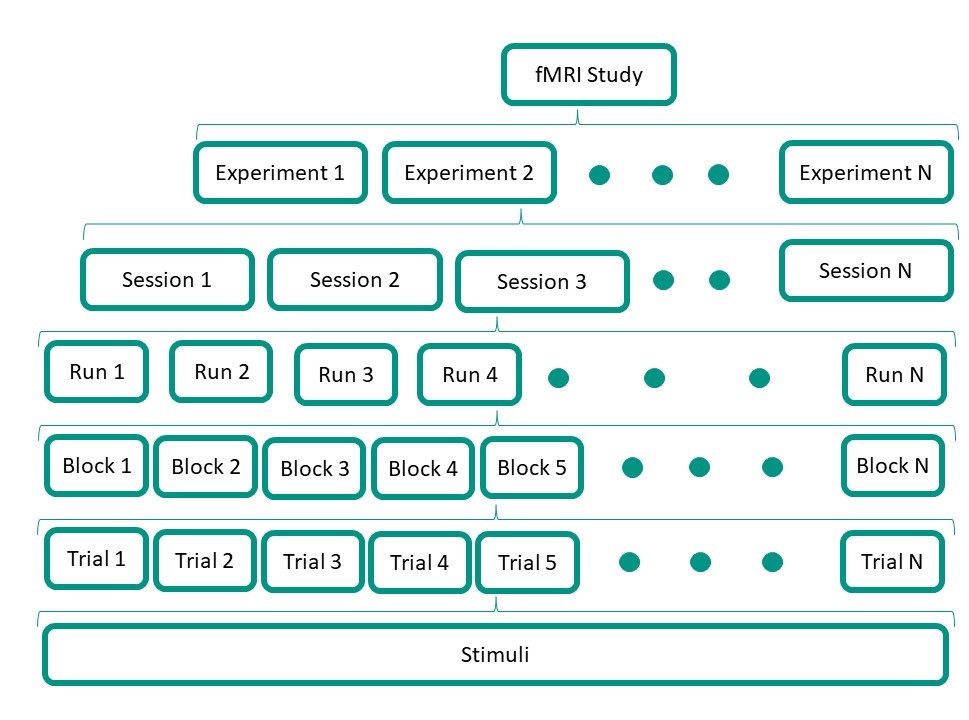fMRI experiment
Typically, a fMRI study acquiers a couple of experiments to accummulate evidence for their hypothesis. Such experiment starts first of with a well designed paradigma that can evoke the intended neuronal activity. This is commonly done by presenting stimuli to the person lying in the scanner. Stimuli can come from different modalities, however most frequently images are displayed on a mirrored screen for the participant to see. How these pictures are arranged and what the participant has to do is all part of the paradigma design. This needs to be best optimized, to get the best data possible. Check out the study design page for more information.
Each experiment includes datacollection at one or multiple timepoints called sessions. As soon as a person is put into the scanner the session starts and it ends, when the person leaves the scanner. Also if it is only for a short coffee break! Differences between sessions are often large in terms of head positioning, therefore they need to be aligned differently as when comparing runs. Runs are scanning units that are seperated most often by breaks in the scanner. Here the participant keeps their head position fixed, but takes a rest from any cognitive task. One session can contain several runs, especially, when there are multiple tasks at play.
Within each run there are a specific set of stimuli presented either as a event or in a block.
-
Event-related Design Stimuli are presented in an randomised order in a randomized fashion along the trial.
-
Block Design Stimuli from the same condition are presented in succession within a specific time-interval.
Stimuli are often not presented by themselves, but are followed by a short baseline (e.g. fixation) in order to prevent overlap of the BOLD signal. This is called an interstimulus intervall (ISI) with a duration that is frequently randomly jittered. Together they combine into a trial.
Thus a block consists of multiple trials that are of the same condition, i.e. show depiction of faces and a run combines multiple blocks of different conditions, such as faces, houses and baseline.
Event-related or blocked Design?¶
Both design types have their disadvantages. The problem with block design is habituation of the signal. This means that when similar stimuli are shown repeatedly, that the activation will not be as high as it has been initially. Anticipation is another problem. Participants can know what to expect within a block and can react in a certain way. This is more difficult for event-related designs. Event-related designs can capture the direct responses to a specific trial. That means that they are sensitive to the shape and timing of the HRF. They are also less sensitive to head motion artifacts but generate less BOLD signal changes than block designs. Thus block designs tend to be more robust and have better statistical power.
Interstimulus Intervall (ISI)¶
The duration between stimuli presentations is called the interstimulus intervall, in short ISI. Depending on its length the BOLD response can vary. If the ISI is too short, then the BOLD response of consecutive stimuli will overlap and the signal starts to saturate. If the ISI is too long, then one needs more time to measure the same amount of stimuli activation and this can be very inefficient. Activation averaging will result in less activation and less power if the number of trials are reduced.
Jittering¶
A jitter is often added to the ISI that makes the ISI variable. Adding such jitter increases BOLD response estimation, avoids time-point correlations between tasks and reduces the expectation effect.
Resources¶
Amaro Jr, E., & Barker, G. J. (2006). Study design in fMRI: basic principles. Brain and cognition, 60(3), 220-232.
Mechelli, A., Henson, R. N., Price, C. J., & Friston, K. J. (2003). Comparing event-related and epoch analysis in blocked design fMRI. Neuroimage, 18(3), 806-810.

